The Interplay of Leadership, Management, and Operations in Business
VerifiedAdded on 2019/12/28
|10
|3036
|147
Report
AI Summary
This report provides a comprehensive comparison of the roles and characteristics of leaders and managers, highlighting their distinct responsibilities within an organization. It delves into the context-specific roles of managers and leaders, exploring various leadership theories and models. The report examines key approaches to operational management, emphasizing the importance of both leadership and managerial roles in achieving business objectives. Furthermore, it analyzes the impact of internal and external factors, such as financial variables, supplier relationships, and competitor analysis, on business operations, including PESTLE and SWOT analysis. The report underscores the significance of operational management in the day-to-day activities of an organization, contributing to its success and long-term sustainability. This report is contributed by a student to be published on the website Desklib, a platform which provides all the necessary AI based study tools for students.
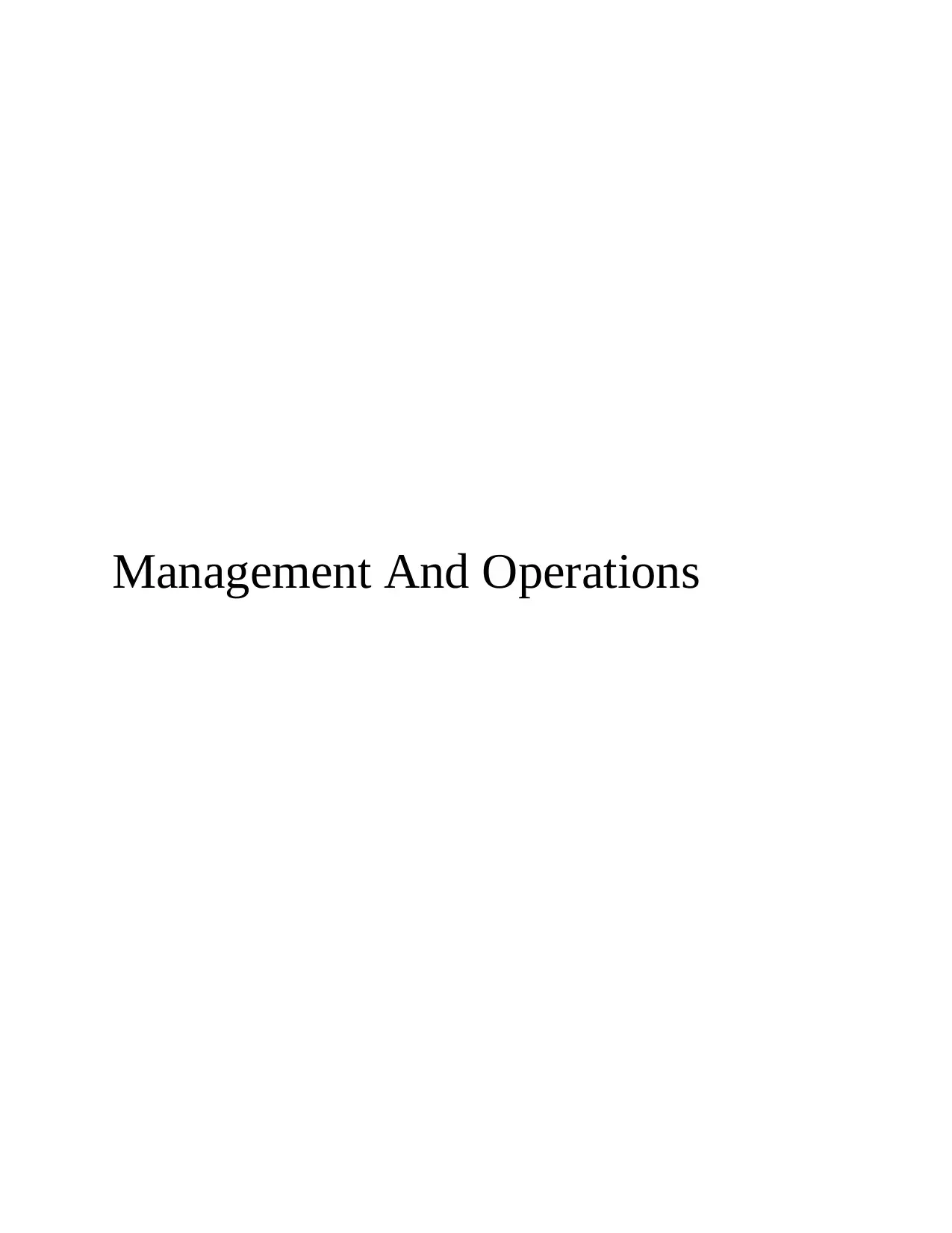
Management And Operations
Paraphrase This Document
Need a fresh take? Get an instant paraphrase of this document with our AI Paraphraser
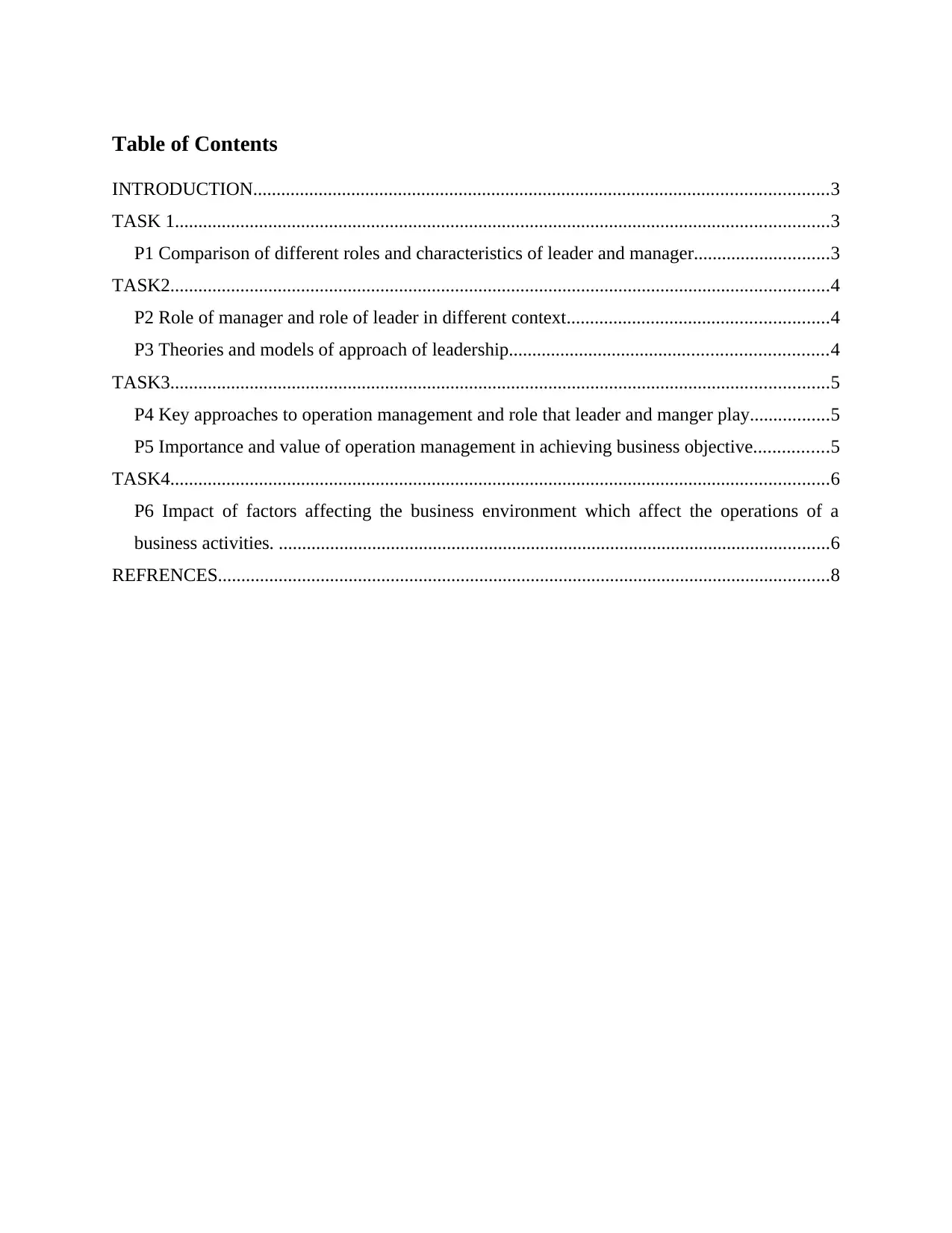
Table of Contents
INTRODUCTION...........................................................................................................................3
TASK 1............................................................................................................................................3
P1 Comparison of different roles and characteristics of leader and manager.............................3
TASK2.............................................................................................................................................4
P2 Role of manager and role of leader in different context........................................................4
P3 Theories and models of approach of leadership....................................................................4
TASK3.............................................................................................................................................5
P4 Key approaches to operation management and role that leader and manger play.................5
P5 Importance and value of operation management in achieving business objective................5
TASK4.............................................................................................................................................6
P6 Impact of factors affecting the business environment which affect the operations of a
business activities. ......................................................................................................................6
REFRENCES...................................................................................................................................8
INTRODUCTION...........................................................................................................................3
TASK 1............................................................................................................................................3
P1 Comparison of different roles and characteristics of leader and manager.............................3
TASK2.............................................................................................................................................4
P2 Role of manager and role of leader in different context........................................................4
P3 Theories and models of approach of leadership....................................................................4
TASK3.............................................................................................................................................5
P4 Key approaches to operation management and role that leader and manger play.................5
P5 Importance and value of operation management in achieving business objective................5
TASK4.............................................................................................................................................6
P6 Impact of factors affecting the business environment which affect the operations of a
business activities. ......................................................................................................................6
REFRENCES...................................................................................................................................8
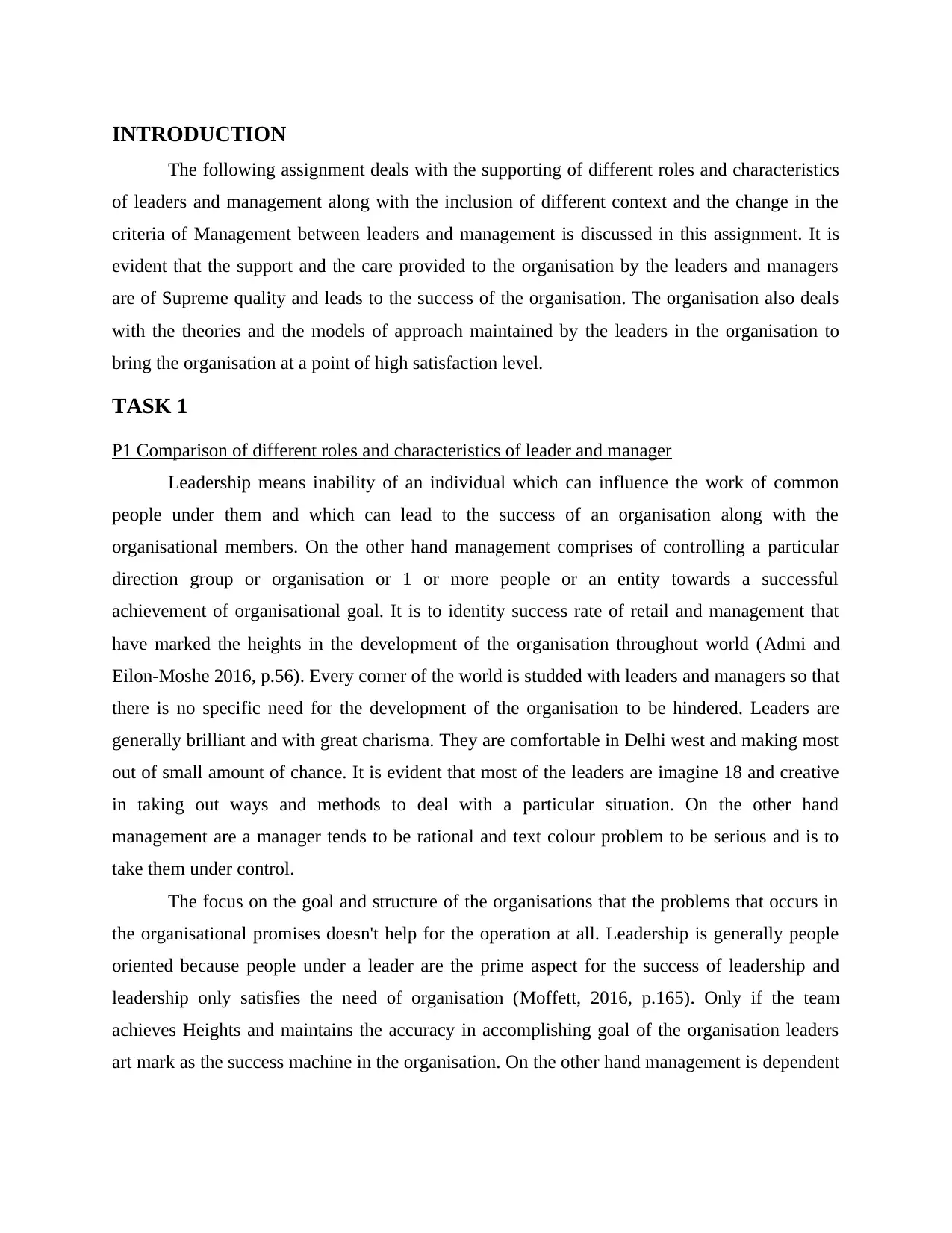
INTRODUCTION
The following assignment deals with the supporting of different roles and characteristics
of leaders and management along with the inclusion of different context and the change in the
criteria of Management between leaders and management is discussed in this assignment. It is
evident that the support and the care provided to the organisation by the leaders and managers
are of Supreme quality and leads to the success of the organisation. The organisation also deals
with the theories and the models of approach maintained by the leaders in the organisation to
bring the organisation at a point of high satisfaction level.
TASK 1
P1 Comparison of different roles and characteristics of leader and manager
Leadership means inability of an individual which can influence the work of common
people under them and which can lead to the success of an organisation along with the
organisational members. On the other hand management comprises of controlling a particular
direction group or organisation or 1 or more people or an entity towards a successful
achievement of organisational goal. It is to identity success rate of retail and management that
have marked the heights in the development of the organisation throughout world (Admi and
Eilon-Moshe 2016, p.56). Every corner of the world is studded with leaders and managers so that
there is no specific need for the development of the organisation to be hindered. Leaders are
generally brilliant and with great charisma. They are comfortable in Delhi west and making most
out of small amount of chance. It is evident that most of the leaders are imagine 18 and creative
in taking out ways and methods to deal with a particular situation. On the other hand
management are a manager tends to be rational and text colour problem to be serious and is to
take them under control.
The focus on the goal and structure of the organisations that the problems that occurs in
the organisational promises doesn't help for the operation at all. Leadership is generally people
oriented because people under a leader are the prime aspect for the success of leadership and
leadership only satisfies the need of organisation (Moffett, 2016, p.165). Only if the team
achieves Heights and maintains the accuracy in accomplishing goal of the organisation leaders
art mark as the success machine in the organisation. On the other hand management is dependent
The following assignment deals with the supporting of different roles and characteristics
of leaders and management along with the inclusion of different context and the change in the
criteria of Management between leaders and management is discussed in this assignment. It is
evident that the support and the care provided to the organisation by the leaders and managers
are of Supreme quality and leads to the success of the organisation. The organisation also deals
with the theories and the models of approach maintained by the leaders in the organisation to
bring the organisation at a point of high satisfaction level.
TASK 1
P1 Comparison of different roles and characteristics of leader and manager
Leadership means inability of an individual which can influence the work of common
people under them and which can lead to the success of an organisation along with the
organisational members. On the other hand management comprises of controlling a particular
direction group or organisation or 1 or more people or an entity towards a successful
achievement of organisational goal. It is to identity success rate of retail and management that
have marked the heights in the development of the organisation throughout world (Admi and
Eilon-Moshe 2016, p.56). Every corner of the world is studded with leaders and managers so that
there is no specific need for the development of the organisation to be hindered. Leaders are
generally brilliant and with great charisma. They are comfortable in Delhi west and making most
out of small amount of chance. It is evident that most of the leaders are imagine 18 and creative
in taking out ways and methods to deal with a particular situation. On the other hand
management are a manager tends to be rational and text colour problem to be serious and is to
take them under control.
The focus on the goal and structure of the organisations that the problems that occurs in
the organisational promises doesn't help for the operation at all. Leadership is generally people
oriented because people under a leader are the prime aspect for the success of leadership and
leadership only satisfies the need of organisation (Moffett, 2016, p.165). Only if the team
achieves Heights and maintains the accuracy in accomplishing goal of the organisation leaders
art mark as the success machine in the organisation. On the other hand management is dependent
⊘ This is a preview!⊘
Do you want full access?
Subscribe today to unlock all pages.

Trusted by 1+ million students worldwide
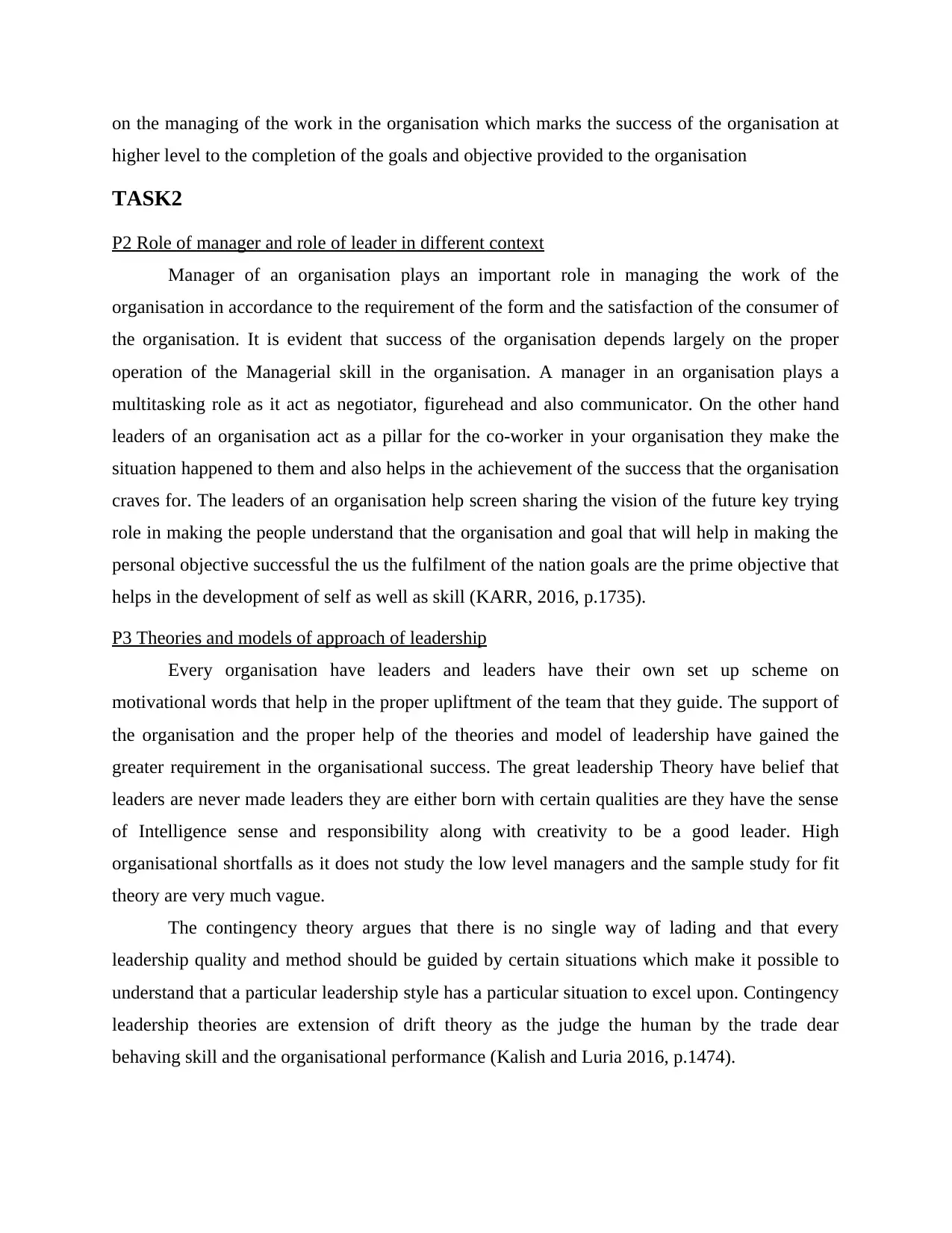
on the managing of the work in the organisation which marks the success of the organisation at
higher level to the completion of the goals and objective provided to the organisation
TASK2
P2 Role of manager and role of leader in different context
Manager of an organisation plays an important role in managing the work of the
organisation in accordance to the requirement of the form and the satisfaction of the consumer of
the organisation. It is evident that success of the organisation depends largely on the proper
operation of the Managerial skill in the organisation. A manager in an organisation plays a
multitasking role as it act as negotiator, figurehead and also communicator. On the other hand
leaders of an organisation act as a pillar for the co-worker in your organisation they make the
situation happened to them and also helps in the achievement of the success that the organisation
craves for. The leaders of an organisation help screen sharing the vision of the future key trying
role in making the people understand that the organisation and goal that will help in making the
personal objective successful the us the fulfilment of the nation goals are the prime objective that
helps in the development of self as well as skill (KARR, 2016, p.1735).
P3 Theories and models of approach of leadership
Every organisation have leaders and leaders have their own set up scheme on
motivational words that help in the proper upliftment of the team that they guide. The support of
the organisation and the proper help of the theories and model of leadership have gained the
greater requirement in the organisational success. The great leadership Theory have belief that
leaders are never made leaders they are either born with certain qualities are they have the sense
of Intelligence sense and responsibility along with creativity to be a good leader. High
organisational shortfalls as it does not study the low level managers and the sample study for fit
theory are very much vague.
The contingency theory argues that there is no single way of lading and that every
leadership quality and method should be guided by certain situations which make it possible to
understand that a particular leadership style has a particular situation to excel upon. Contingency
leadership theories are extension of drift theory as the judge the human by the trade dear
behaving skill and the organisational performance (Kalish and Luria 2016, p.1474).
higher level to the completion of the goals and objective provided to the organisation
TASK2
P2 Role of manager and role of leader in different context
Manager of an organisation plays an important role in managing the work of the
organisation in accordance to the requirement of the form and the satisfaction of the consumer of
the organisation. It is evident that success of the organisation depends largely on the proper
operation of the Managerial skill in the organisation. A manager in an organisation plays a
multitasking role as it act as negotiator, figurehead and also communicator. On the other hand
leaders of an organisation act as a pillar for the co-worker in your organisation they make the
situation happened to them and also helps in the achievement of the success that the organisation
craves for. The leaders of an organisation help screen sharing the vision of the future key trying
role in making the people understand that the organisation and goal that will help in making the
personal objective successful the us the fulfilment of the nation goals are the prime objective that
helps in the development of self as well as skill (KARR, 2016, p.1735).
P3 Theories and models of approach of leadership
Every organisation have leaders and leaders have their own set up scheme on
motivational words that help in the proper upliftment of the team that they guide. The support of
the organisation and the proper help of the theories and model of leadership have gained the
greater requirement in the organisational success. The great leadership Theory have belief that
leaders are never made leaders they are either born with certain qualities are they have the sense
of Intelligence sense and responsibility along with creativity to be a good leader. High
organisational shortfalls as it does not study the low level managers and the sample study for fit
theory are very much vague.
The contingency theory argues that there is no single way of lading and that every
leadership quality and method should be guided by certain situations which make it possible to
understand that a particular leadership style has a particular situation to excel upon. Contingency
leadership theories are extension of drift theory as the judge the human by the trade dear
behaving skill and the organisational performance (Kalish and Luria 2016, p.1474).
Paraphrase This Document
Need a fresh take? Get an instant paraphrase of this document with our AI Paraphraser
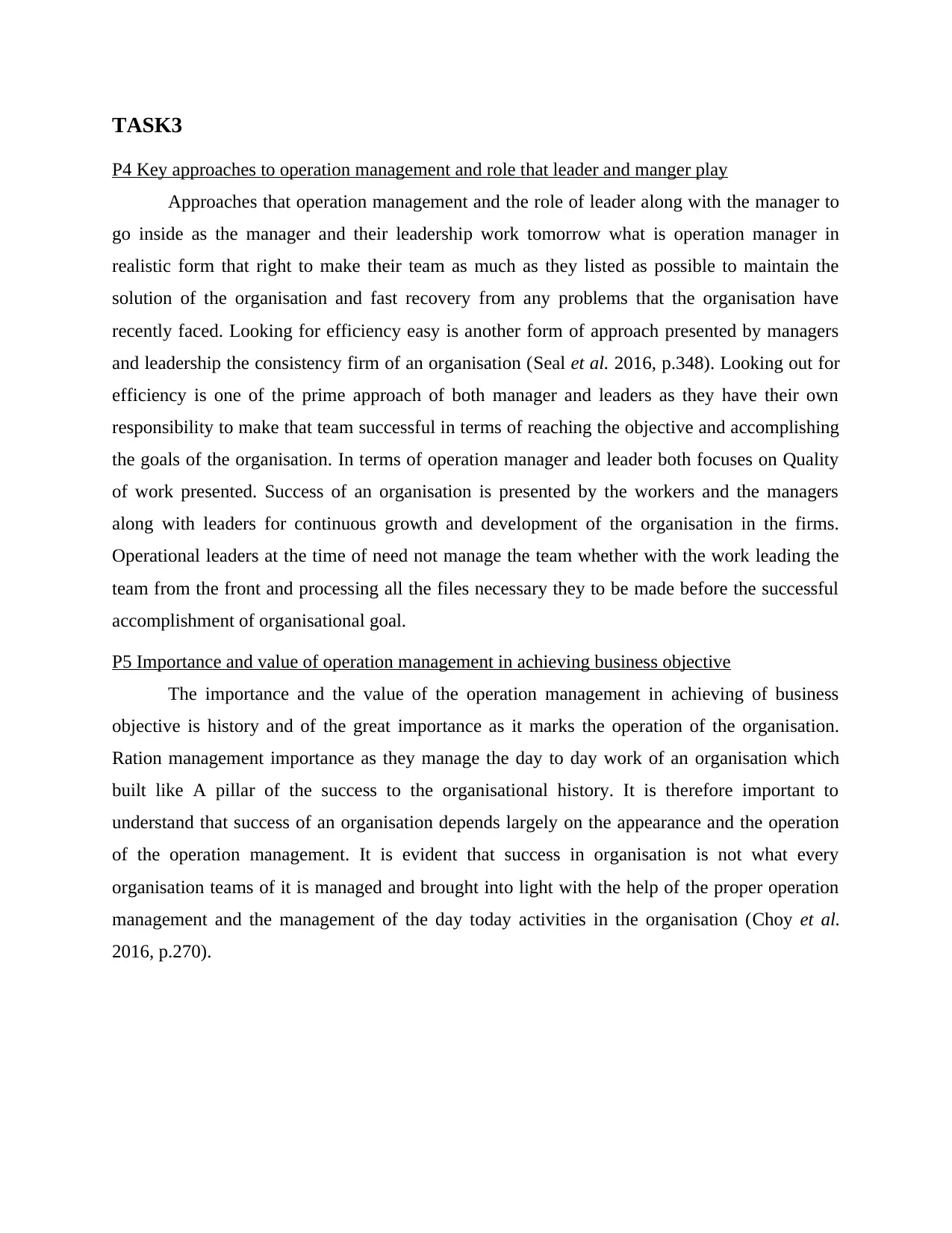
TASK3
P4 Key approaches to operation management and role that leader and manger play
Approaches that operation management and the role of leader along with the manager to
go inside as the manager and their leadership work tomorrow what is operation manager in
realistic form that right to make their team as much as they listed as possible to maintain the
solution of the organisation and fast recovery from any problems that the organisation have
recently faced. Looking for efficiency easy is another form of approach presented by managers
and leadership the consistency firm of an organisation (Seal et al. 2016, p.348). Looking out for
efficiency is one of the prime approach of both manager and leaders as they have their own
responsibility to make that team successful in terms of reaching the objective and accomplishing
the goals of the organisation. In terms of operation manager and leader both focuses on Quality
of work presented. Success of an organisation is presented by the workers and the managers
along with leaders for continuous growth and development of the organisation in the firms.
Operational leaders at the time of need not manage the team whether with the work leading the
team from the front and processing all the files necessary they to be made before the successful
accomplishment of organisational goal.
P5 Importance and value of operation management in achieving business objective
The importance and the value of the operation management in achieving of business
objective is history and of the great importance as it marks the operation of the organisation.
Ration management importance as they manage the day to day work of an organisation which
built like A pillar of the success to the organisational history. It is therefore important to
understand that success of an organisation depends largely on the appearance and the operation
of the operation management. It is evident that success in organisation is not what every
organisation teams of it is managed and brought into light with the help of the proper operation
management and the management of the day today activities in the organisation (Choy et al.
2016, p.270).
P4 Key approaches to operation management and role that leader and manger play
Approaches that operation management and the role of leader along with the manager to
go inside as the manager and their leadership work tomorrow what is operation manager in
realistic form that right to make their team as much as they listed as possible to maintain the
solution of the organisation and fast recovery from any problems that the organisation have
recently faced. Looking for efficiency easy is another form of approach presented by managers
and leadership the consistency firm of an organisation (Seal et al. 2016, p.348). Looking out for
efficiency is one of the prime approach of both manager and leaders as they have their own
responsibility to make that team successful in terms of reaching the objective and accomplishing
the goals of the organisation. In terms of operation manager and leader both focuses on Quality
of work presented. Success of an organisation is presented by the workers and the managers
along with leaders for continuous growth and development of the organisation in the firms.
Operational leaders at the time of need not manage the team whether with the work leading the
team from the front and processing all the files necessary they to be made before the successful
accomplishment of organisational goal.
P5 Importance and value of operation management in achieving business objective
The importance and the value of the operation management in achieving of business
objective is history and of the great importance as it marks the operation of the organisation.
Ration management importance as they manage the day to day work of an organisation which
built like A pillar of the success to the organisational history. It is therefore important to
understand that success of an organisation depends largely on the appearance and the operation
of the operation management. It is evident that success in organisation is not what every
organisation teams of it is managed and brought into light with the help of the proper operation
management and the management of the day today activities in the organisation (Choy et al.
2016, p.270).
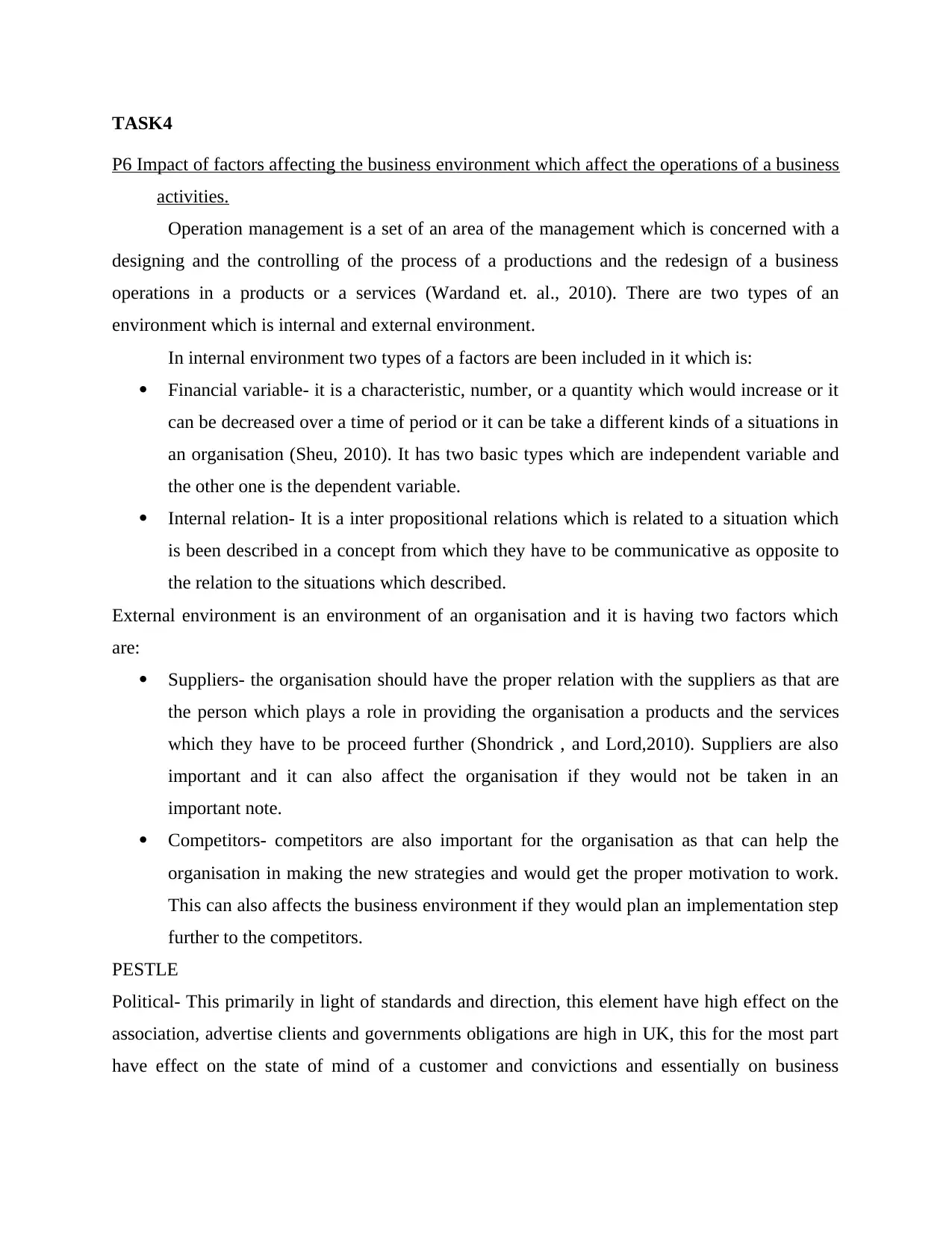
TASK4
P6 Impact of factors affecting the business environment which affect the operations of a business
activities.
Operation management is a set of an area of the management which is concerned with a
designing and the controlling of the process of a productions and the redesign of a business
operations in a products or a services (Wardand et. al., 2010). There are two types of an
environment which is internal and external environment.
In internal environment two types of a factors are been included in it which is:
Financial variable- it is a characteristic, number, or a quantity which would increase or it
can be decreased over a time of period or it can be take a different kinds of a situations in
an organisation (Sheu, 2010). It has two basic types which are independent variable and
the other one is the dependent variable.
Internal relation- It is a inter propositional relations which is related to a situation which
is been described in a concept from which they have to be communicative as opposite to
the relation to the situations which described.
External environment is an environment of an organisation and it is having two factors which
are:
Suppliers- the organisation should have the proper relation with the suppliers as that are
the person which plays a role in providing the organisation a products and the services
which they have to be proceed further (Shondrick , and Lord,2010). Suppliers are also
important and it can also affect the organisation if they would not be taken in an
important note.
Competitors- competitors are also important for the organisation as that can help the
organisation in making the new strategies and would get the proper motivation to work.
This can also affects the business environment if they would plan an implementation step
further to the competitors.
PESTLE
Political- This primarily in light of standards and direction, this element have high effect on the
association, advertise clients and governments obligations are high in UK, this for the most part
have effect on the state of mind of a customer and convictions and essentially on business
P6 Impact of factors affecting the business environment which affect the operations of a business
activities.
Operation management is a set of an area of the management which is concerned with a
designing and the controlling of the process of a productions and the redesign of a business
operations in a products or a services (Wardand et. al., 2010). There are two types of an
environment which is internal and external environment.
In internal environment two types of a factors are been included in it which is:
Financial variable- it is a characteristic, number, or a quantity which would increase or it
can be decreased over a time of period or it can be take a different kinds of a situations in
an organisation (Sheu, 2010). It has two basic types which are independent variable and
the other one is the dependent variable.
Internal relation- It is a inter propositional relations which is related to a situation which
is been described in a concept from which they have to be communicative as opposite to
the relation to the situations which described.
External environment is an environment of an organisation and it is having two factors which
are:
Suppliers- the organisation should have the proper relation with the suppliers as that are
the person which plays a role in providing the organisation a products and the services
which they have to be proceed further (Shondrick , and Lord,2010). Suppliers are also
important and it can also affect the organisation if they would not be taken in an
important note.
Competitors- competitors are also important for the organisation as that can help the
organisation in making the new strategies and would get the proper motivation to work.
This can also affects the business environment if they would plan an implementation step
further to the competitors.
PESTLE
Political- This primarily in light of standards and direction, this element have high effect on the
association, advertise clients and governments obligations are high in UK, this for the most part
have effect on the state of mind of a customer and convictions and essentially on business
⊘ This is a preview!⊘
Do you want full access?
Subscribe today to unlock all pages.

Trusted by 1+ million students worldwide
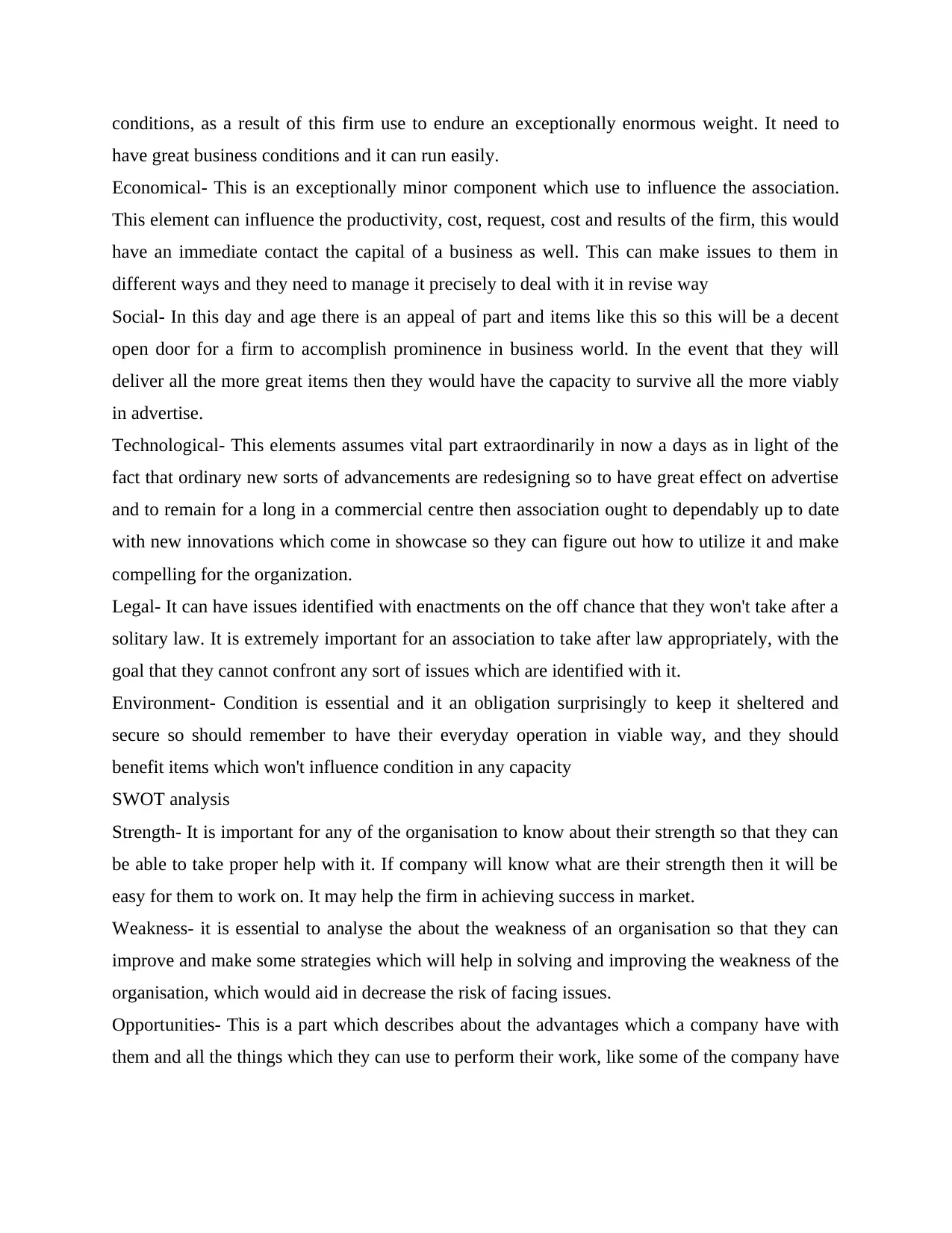
conditions, as a result of this firm use to endure an exceptionally enormous weight. It need to
have great business conditions and it can run easily.
Economical- This is an exceptionally minor component which use to influence the association.
This element can influence the productivity, cost, request, cost and results of the firm, this would
have an immediate contact the capital of a business as well. This can make issues to them in
different ways and they need to manage it precisely to deal with it in revise way
Social- In this day and age there is an appeal of part and items like this so this will be a decent
open door for a firm to accomplish prominence in business world. In the event that they will
deliver all the more great items then they would have the capacity to survive all the more viably
in advertise.
Technological- This elements assumes vital part extraordinarily in now a days as in light of the
fact that ordinary new sorts of advancements are redesigning so to have great effect on advertise
and to remain for a long in a commercial centre then association ought to dependably up to date
with new innovations which come in showcase so they can figure out how to utilize it and make
compelling for the organization.
Legal- It can have issues identified with enactments on the off chance that they won't take after a
solitary law. It is extremely important for an association to take after law appropriately, with the
goal that they cannot confront any sort of issues which are identified with it.
Environment- Condition is essential and it an obligation surprisingly to keep it sheltered and
secure so should remember to have their everyday operation in viable way, and they should
benefit items which won't influence condition in any capacity
SWOT analysis
Strength- It is important for any of the organisation to know about their strength so that they can
be able to take proper help with it. If company will know what are their strength then it will be
easy for them to work on. It may help the firm in achieving success in market.
Weakness- it is essential to analyse the about the weakness of an organisation so that they can
improve and make some strategies which will help in solving and improving the weakness of the
organisation, which would aid in decrease the risk of facing issues.
Opportunities- This is a part which describes about the advantages which a company have with
them and all the things which they can use to perform their work, like some of the company have
have great business conditions and it can run easily.
Economical- This is an exceptionally minor component which use to influence the association.
This element can influence the productivity, cost, request, cost and results of the firm, this would
have an immediate contact the capital of a business as well. This can make issues to them in
different ways and they need to manage it precisely to deal with it in revise way
Social- In this day and age there is an appeal of part and items like this so this will be a decent
open door for a firm to accomplish prominence in business world. In the event that they will
deliver all the more great items then they would have the capacity to survive all the more viably
in advertise.
Technological- This elements assumes vital part extraordinarily in now a days as in light of the
fact that ordinary new sorts of advancements are redesigning so to have great effect on advertise
and to remain for a long in a commercial centre then association ought to dependably up to date
with new innovations which come in showcase so they can figure out how to utilize it and make
compelling for the organization.
Legal- It can have issues identified with enactments on the off chance that they won't take after a
solitary law. It is extremely important for an association to take after law appropriately, with the
goal that they cannot confront any sort of issues which are identified with it.
Environment- Condition is essential and it an obligation surprisingly to keep it sheltered and
secure so should remember to have their everyday operation in viable way, and they should
benefit items which won't influence condition in any capacity
SWOT analysis
Strength- It is important for any of the organisation to know about their strength so that they can
be able to take proper help with it. If company will know what are their strength then it will be
easy for them to work on. It may help the firm in achieving success in market.
Weakness- it is essential to analyse the about the weakness of an organisation so that they can
improve and make some strategies which will help in solving and improving the weakness of the
organisation, which would aid in decrease the risk of facing issues.
Opportunities- This is a part which describes about the advantages which a company have with
them and all the things which they can use to perform their work, like some of the company have
Paraphrase This Document
Need a fresh take? Get an instant paraphrase of this document with our AI Paraphraser
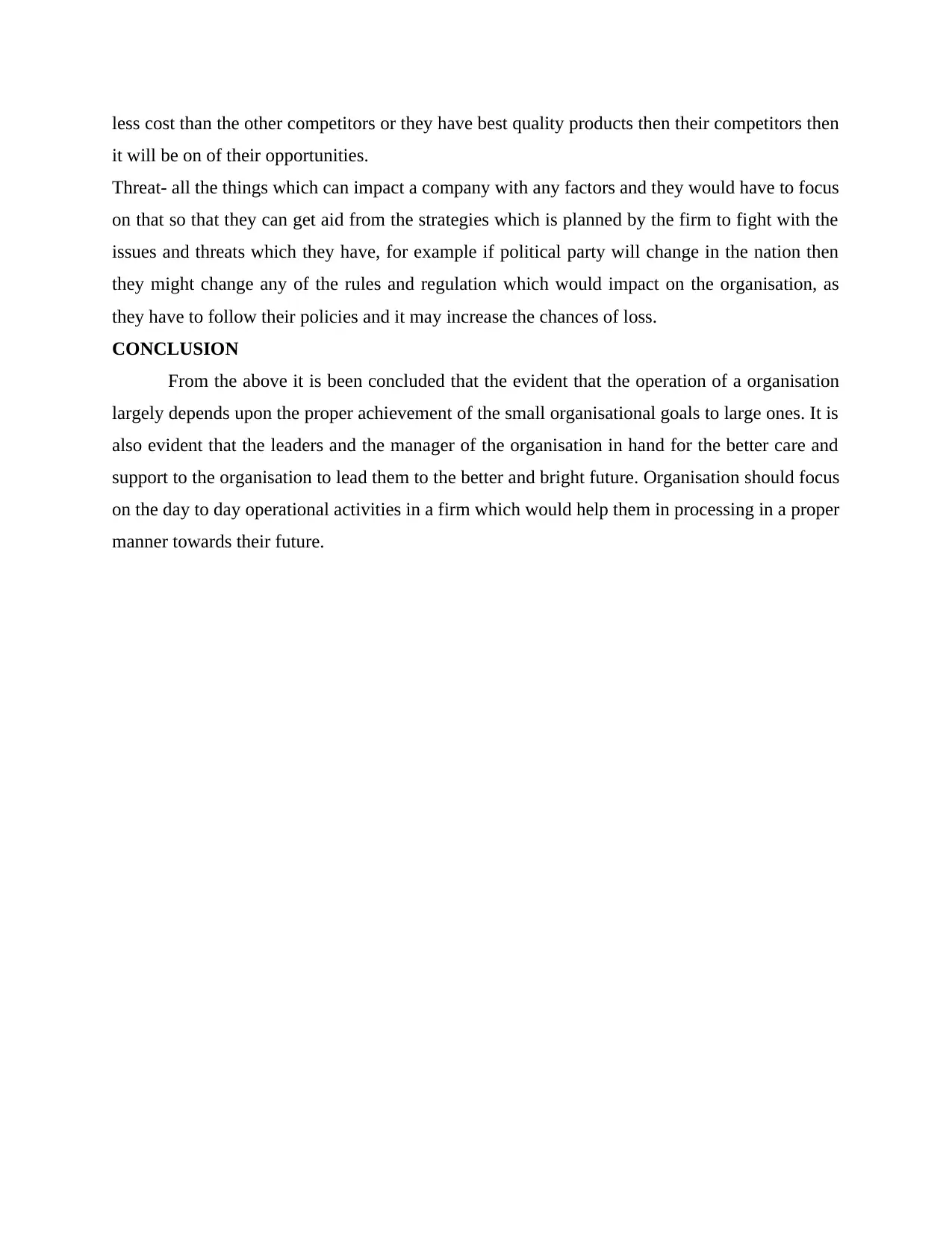
less cost than the other competitors or they have best quality products then their competitors then
it will be on of their opportunities.
Threat- all the things which can impact a company with any factors and they would have to focus
on that so that they can get aid from the strategies which is planned by the firm to fight with the
issues and threats which they have, for example if political party will change in the nation then
they might change any of the rules and regulation which would impact on the organisation, as
they have to follow their policies and it may increase the chances of loss.
CONCLUSION
From the above it is been concluded that the evident that the operation of a organisation
largely depends upon the proper achievement of the small organisational goals to large ones. It is
also evident that the leaders and the manager of the organisation in hand for the better care and
support to the organisation to lead them to the better and bright future. Organisation should focus
on the day to day operational activities in a firm which would help them in processing in a proper
manner towards their future.
it will be on of their opportunities.
Threat- all the things which can impact a company with any factors and they would have to focus
on that so that they can get aid from the strategies which is planned by the firm to fight with the
issues and threats which they have, for example if political party will change in the nation then
they might change any of the rules and regulation which would impact on the organisation, as
they have to follow their policies and it may increase the chances of loss.
CONCLUSION
From the above it is been concluded that the evident that the operation of a organisation
largely depends upon the proper achievement of the small organisational goals to large ones. It is
also evident that the leaders and the manager of the organisation in hand for the better care and
support to the organisation to lead them to the better and bright future. Organisation should focus
on the day to day operational activities in a firm which would help them in processing in a proper
manner towards their future.
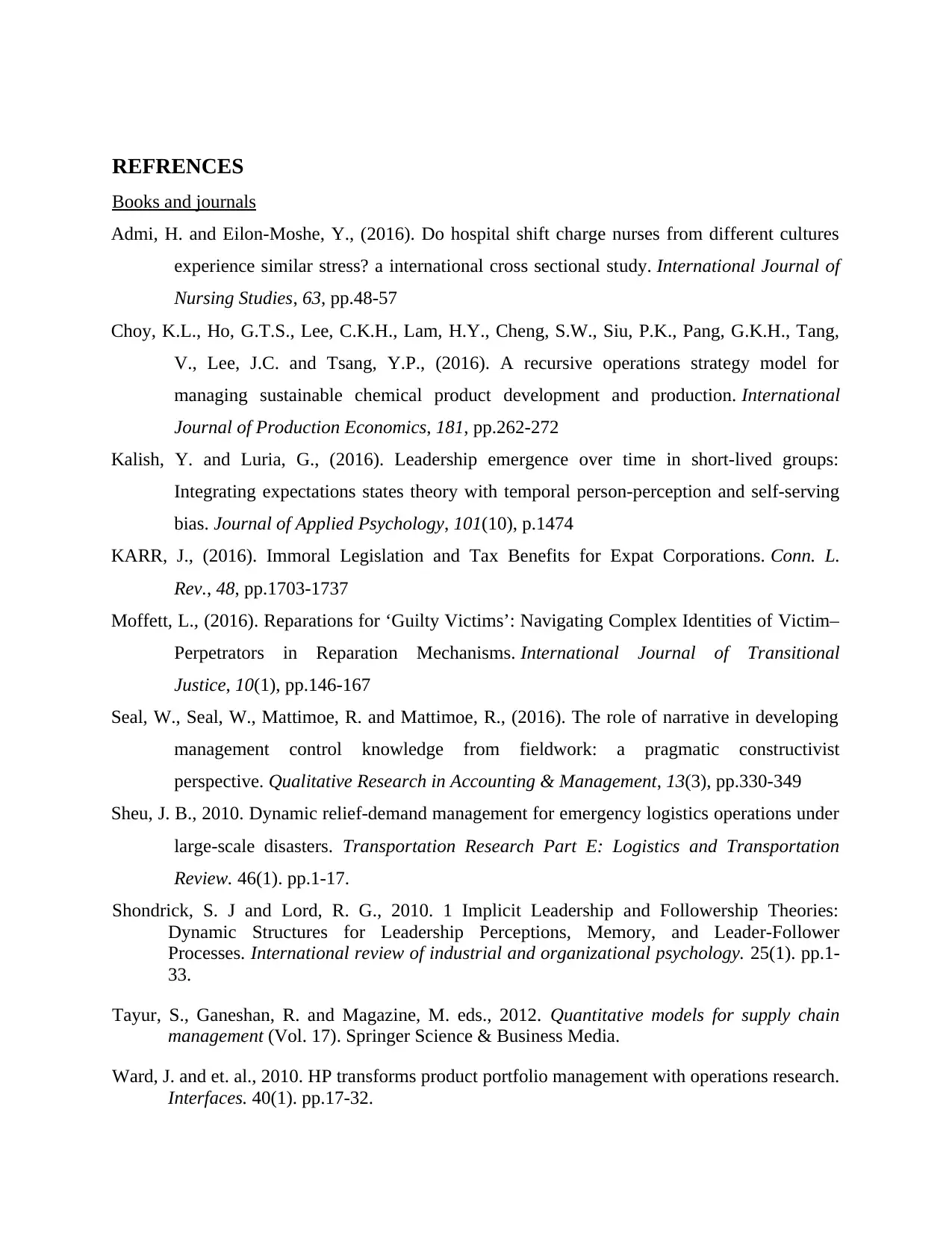
REFRENCES
Books and journals
Admi, H. and Eilon-Moshe, Y., (2016). Do hospital shift charge nurses from different cultures
experience similar stress? a international cross sectional study. International Journal of
Nursing Studies, 63, pp.48-57
Choy, K.L., Ho, G.T.S., Lee, C.K.H., Lam, H.Y., Cheng, S.W., Siu, P.K., Pang, G.K.H., Tang,
V., Lee, J.C. and Tsang, Y.P., (2016). A recursive operations strategy model for
managing sustainable chemical product development and production. International
Journal of Production Economics, 181, pp.262-272
Kalish, Y. and Luria, G., (2016). Leadership emergence over time in short-lived groups:
Integrating expectations states theory with temporal person-perception and self-serving
bias. Journal of Applied Psychology, 101(10), p.1474
KARR, J., (2016). Immoral Legislation and Tax Benefits for Expat Corporations. Conn. L.
Rev., 48, pp.1703-1737
Moffett, L., (2016). Reparations for ‘Guilty Victims’: Navigating Complex Identities of Victim–
Perpetrators in Reparation Mechanisms. International Journal of Transitional
Justice, 10(1), pp.146-167
Seal, W., Seal, W., Mattimoe, R. and Mattimoe, R., (2016). The role of narrative in developing
management control knowledge from fieldwork: a pragmatic constructivist
perspective. Qualitative Research in Accounting & Management, 13(3), pp.330-349
Sheu, J. B., 2010. Dynamic relief-demand management for emergency logistics operations under
large-scale disasters. Transportation Research Part E: Logistics and Transportation
Review. 46(1). pp.1-17.
Shondrick, S. J and Lord, R. G., 2010. 1 Implicit Leadership and Followership Theories:
Dynamic Structures for Leadership Perceptions, Memory, and Leader-Follower
Processes. International review of industrial and organizational psychology. 25(1). pp.1-
33.
Tayur, S., Ganeshan, R. and Magazine, M. eds., 2012. Quantitative models for supply chain
management (Vol. 17). Springer Science & Business Media.
Ward, J. and et. al., 2010. HP transforms product portfolio management with operations research.
Interfaces. 40(1). pp.17-32.
Books and journals
Admi, H. and Eilon-Moshe, Y., (2016). Do hospital shift charge nurses from different cultures
experience similar stress? a international cross sectional study. International Journal of
Nursing Studies, 63, pp.48-57
Choy, K.L., Ho, G.T.S., Lee, C.K.H., Lam, H.Y., Cheng, S.W., Siu, P.K., Pang, G.K.H., Tang,
V., Lee, J.C. and Tsang, Y.P., (2016). A recursive operations strategy model for
managing sustainable chemical product development and production. International
Journal of Production Economics, 181, pp.262-272
Kalish, Y. and Luria, G., (2016). Leadership emergence over time in short-lived groups:
Integrating expectations states theory with temporal person-perception and self-serving
bias. Journal of Applied Psychology, 101(10), p.1474
KARR, J., (2016). Immoral Legislation and Tax Benefits for Expat Corporations. Conn. L.
Rev., 48, pp.1703-1737
Moffett, L., (2016). Reparations for ‘Guilty Victims’: Navigating Complex Identities of Victim–
Perpetrators in Reparation Mechanisms. International Journal of Transitional
Justice, 10(1), pp.146-167
Seal, W., Seal, W., Mattimoe, R. and Mattimoe, R., (2016). The role of narrative in developing
management control knowledge from fieldwork: a pragmatic constructivist
perspective. Qualitative Research in Accounting & Management, 13(3), pp.330-349
Sheu, J. B., 2010. Dynamic relief-demand management for emergency logistics operations under
large-scale disasters. Transportation Research Part E: Logistics and Transportation
Review. 46(1). pp.1-17.
Shondrick, S. J and Lord, R. G., 2010. 1 Implicit Leadership and Followership Theories:
Dynamic Structures for Leadership Perceptions, Memory, and Leader-Follower
Processes. International review of industrial and organizational psychology. 25(1). pp.1-
33.
Tayur, S., Ganeshan, R. and Magazine, M. eds., 2012. Quantitative models for supply chain
management (Vol. 17). Springer Science & Business Media.
Ward, J. and et. al., 2010. HP transforms product portfolio management with operations research.
Interfaces. 40(1). pp.17-32.
⊘ This is a preview!⊘
Do you want full access?
Subscribe today to unlock all pages.

Trusted by 1+ million students worldwide
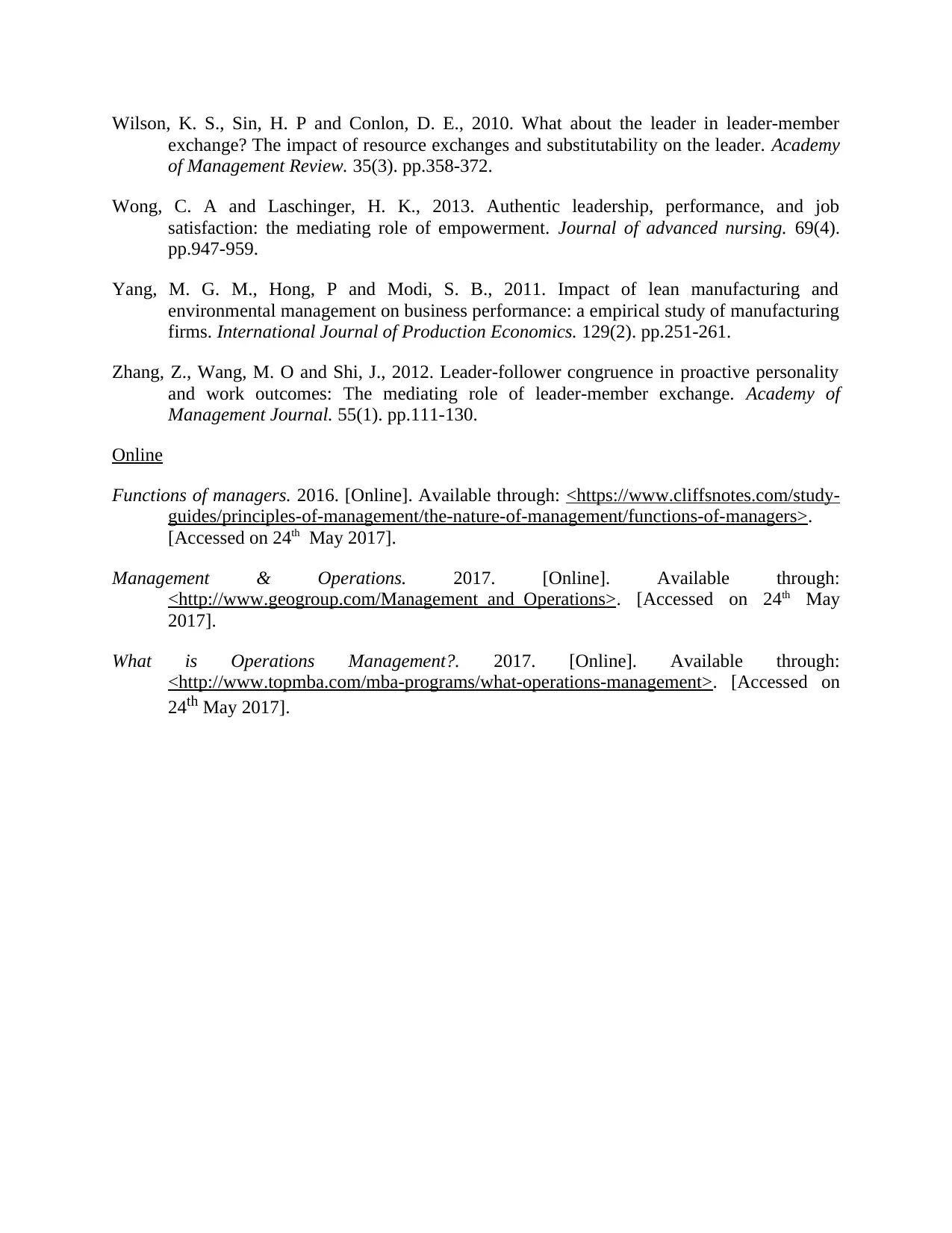
Wilson, K. S., Sin, H. P and Conlon, D. E., 2010. What about the leader in leader-member
exchange? The impact of resource exchanges and substitutability on the leader. Academy
of Management Review. 35(3). pp.358-372.
Wong, C. A and Laschinger, H. K., 2013. Authentic leadership, performance, and job
satisfaction: the mediating role of empowerment. Journal of advanced nursing. 69(4).
pp.947-959.
Yang, M. G. M., Hong, P and Modi, S. B., 2011. Impact of lean manufacturing and
environmental management on business performance: a empirical study of manufacturing
firms. International Journal of Production Economics. 129(2). pp.251-261.
Zhang, Z., Wang, M. O and Shi, J., 2012. Leader-follower congruence in proactive personality
and work outcomes: The mediating role of leader-member exchange. Academy of
Management Journal. 55(1). pp.111-130.
Online
Functions of managers. 2016. [Online]. Available through: <https://www.cliffsnotes.com/study-
guides/principles-of-management/the-nature-of-management/functions-of-managers>.
[Accessed on 24th May 2017].
Management & Operations. 2017. [Online]. Available through:
<http://www.geogroup.com/Management_and_Operations>. [Accessed on 24th May
2017].
What is Operations Management?. 2017. [Online]. Available through:
<http://www.topmba.com/mba-programs/what-operations-management>. [Accessed on
24th May 2017].
exchange? The impact of resource exchanges and substitutability on the leader. Academy
of Management Review. 35(3). pp.358-372.
Wong, C. A and Laschinger, H. K., 2013. Authentic leadership, performance, and job
satisfaction: the mediating role of empowerment. Journal of advanced nursing. 69(4).
pp.947-959.
Yang, M. G. M., Hong, P and Modi, S. B., 2011. Impact of lean manufacturing and
environmental management on business performance: a empirical study of manufacturing
firms. International Journal of Production Economics. 129(2). pp.251-261.
Zhang, Z., Wang, M. O and Shi, J., 2012. Leader-follower congruence in proactive personality
and work outcomes: The mediating role of leader-member exchange. Academy of
Management Journal. 55(1). pp.111-130.
Online
Functions of managers. 2016. [Online]. Available through: <https://www.cliffsnotes.com/study-
guides/principles-of-management/the-nature-of-management/functions-of-managers>.
[Accessed on 24th May 2017].
Management & Operations. 2017. [Online]. Available through:
<http://www.geogroup.com/Management_and_Operations>. [Accessed on 24th May
2017].
What is Operations Management?. 2017. [Online]. Available through:
<http://www.topmba.com/mba-programs/what-operations-management>. [Accessed on
24th May 2017].
1 out of 10
Related Documents
Your All-in-One AI-Powered Toolkit for Academic Success.
+13062052269
info@desklib.com
Available 24*7 on WhatsApp / Email
![[object Object]](/_next/static/media/star-bottom.7253800d.svg)
Unlock your academic potential
Copyright © 2020–2025 A2Z Services. All Rights Reserved. Developed and managed by ZUCOL.





